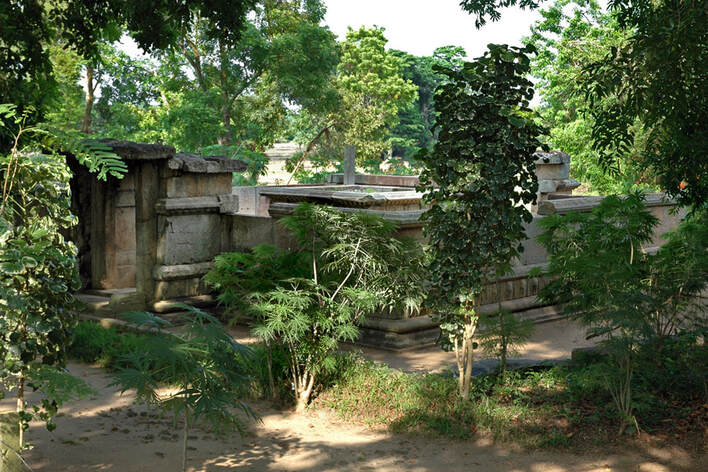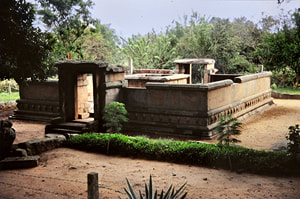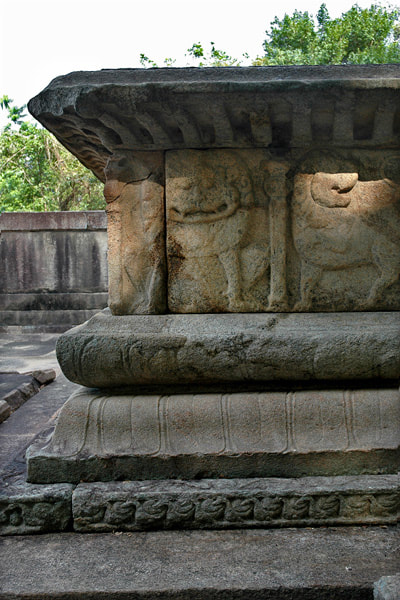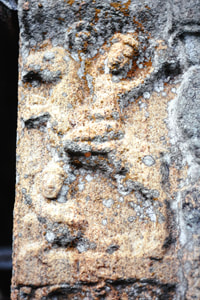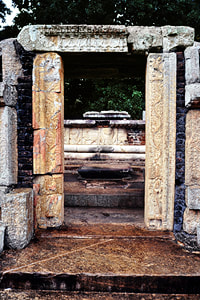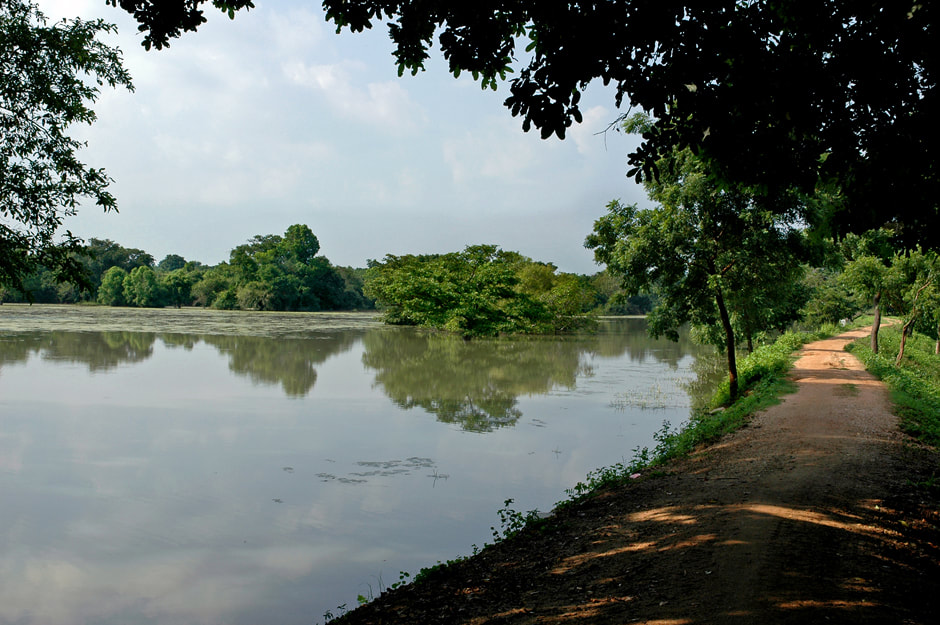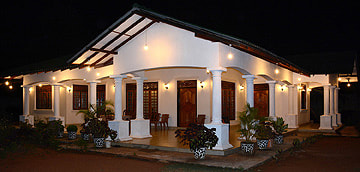The small ancient temple of Nillakgama, situated near the village of Vikadenigama 12 km to the east of Galgamuwa (7.9952 80.3369), is one of the few Bodhigaras that are still in existence. Bodhigara, also spelt Bodhighara or Bodhigaraya, translates to “Bo-tree house”. A Bodhigara was a temple building in which a Bo-tree was venerated. In general, Bo-trees are an integral part of Buddhist Viharas. However, most of the sacred trees that can be seen today are placed on an elevated platforms in a courtyard of the monastery’s premises. This typical arrangement is not a Bodhigara. In a genuine Bodhigara, the tree is surrounded by walls and growing through a large opening in the wooden roof.
Content of our detailed Nillakgama page: name - history - archaeology - architecture - decorations - summary
Bodhigaras are known from depictions on stone carvings from the early periods of Buddhist ar and they are mentioned in ancient Indian literature. Archaeologists believed that none of these ancient temples of tree worship had survived, until the Bodghigara of Nillakgama was excavated. This structure is from the late Anuradhapura period, since an inscription of the 8th or 9th century records the gift of ten of the sculptured elephants on the moulded stone with a frieze of elephants running round the base at the level of the landing. The sacred tree of this Bodhigara has not survived, but the 20 cm thick granite slabs of the walls of the small complex were still in situ and are perfectly well restored. They encompass a granite square of about 10 m in length. Each of the two entrance gates to the east and west is 2 m wide. The outer wall is about 2 m high.
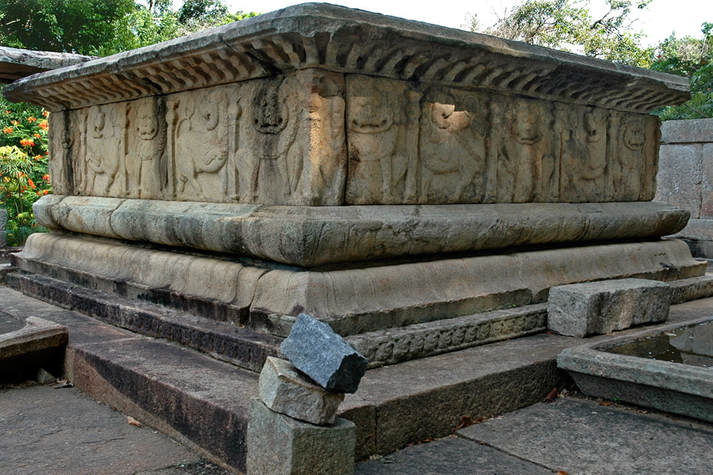
The central stage of 4 m length and width is cased with granite and devorated with a frieze of stone carvings depicting lions. It once carried the Bo-tree. This stage is called Asana, meaning “seat” or throne. Usually, a Buddha image is seated on such a throne in the centre of a temple. However, this is the case in a so-called “image house”, which is the literal translation of Pathimagara. Instead of a sculpture, a Bo-tree is placed on the Asana in the case of a Bodhigara. Four altars on the four sides indicate that an object of veneration was placed on the central Asana. At the Nillaggama Bodhigara, the stoneworks of the stage and of the door-jams and lintels carry exquisite ornamentation.
Of this work of art Dr. Senarath Paranavithana, the doyen of historical research in Sri Lanka, wrote in the Archaeological Survey of Ceylon, Administrative Report 1954 (Colombo 1955):
|
“In its ornamental character, the structure at Nillakgama is not surpassed by any other monument at the prasadas of Anuradhapura. No door-frames so elaborately ornamented as those at Nillakgama are known from any other site as early as the ninth century. A structure on which so much of artistic effort was lavished must have been dedicated to an object of great religious veneration. It is not impossible that the Bodhi-tree which stood at the centre of the upper platform was one believed to have sprung from the seeds of the Anuradhapura Bodhi-tree immediately after it was planted in the reign of Devanampiya Tissa.“
cited from: Ludowyk, Evelyn F. The footprint of the Buddha. New Delhi: Navrang, 1958, p. 91 |
Let’s discuss this remote and rarely visited small structure of the Nillakgama Bodhigara with its excellent decorations in some more detail:
Name of Nillakgama
As usual, there are various English transliterations of Nillakgama. Other spellings are Nillaggama and Nillakkagama. By the way, “Nil-lak-gama” literally means “Blue-Lanka-Village”. Paranavitana called this Bodhigara finding place also “Nitolava”.
History of Bodhigara architecture and tree worship
Nillakgama is not an entire complex of excavated ancient structures but a single temple from the Anuradhapura period and only a small one. This is probably the most remote and hidden temple within the Cultural Triangle, actually off the beaten path. However, travellers should not expect to see much. The comparatively long drive to Nillakgama is only recommendable for heritage site and art history enthusiasts and those who are interested in studying details. Only for them, the Nillakgama Bodhigara will turn out to be a small jewel, due to its decorations and simply as the rare example of a Bodhigara, an ancient tree-temple. In contrast, Chetiyagaras, which are typical for Sri Lanka‘s ancient monastic architecture, are temple buidlings enshrining a small stupa, they can be seen at many places in Sri Lanka. Pathimagaras, shrines containing Buddha images, are most common, they can be seen at almost every Buddhist temple complex. Besides stupa worship and image worship, Tree worship is also common in every Vihara. However, the structures for circumambulating and watering trees ritually are not Bodhigaras but Bodhimaluwas (also spelt "Bomaluvas"), simple terraces or stages, not placed inside buildings. Only Bodhigaras were temple constructions for tree veneration, and although ruins of a few more of them can be seen in Sri Lanka, the small and remote temple of Nillakgama is by far the most remarkable example for this classic type of ancient Buddhist architecture. This is what this article is about.
click for more info about Buddhist tree Veneration & Bodhigaras
Bodhi-tree worship, just as in the case of stupa and relic worship, is one of the earliest forms of Buddhist lay religiosity. Not right from the beginning but only in the course of time, Bodhigaras and stupas have become an integral part of Buddhist monasteries, as these were frequented by laymen supporting and sustaining the monks' order by providing their daily needs and donating edifices. In Buddhism, tree-worship could be legitimized by the fact that, according to a famous legend, the Buddha attained enlightenment under a tree, although this is not mentioned in the early canonical scriptures. Evidently, the popular Bodhi-tree tales concerning the setting of the Buddha's enlightement are later supplements. In the earliest Buddhist works of art, in which the Buddha was not yet been depicted in human form, trees served as symbols representing him, more precisely: the moment of his enlightenment. Legend has it, that all four major events of the Buddha‘s life - birth, enlightenment, first preaching and death – had taken place under trees. Later on, specific tree species were associated with each of the previous Buddhas. Furthermore, even dryads were integrated in Buddhist art, as can be seen from beautifully sculptured women at integrated in depictions of lush trees at the Torana-gateways of the Sanchi Stupa in central India. Tree worship became so deeply integrated into Buddhism that religious writings of ancient Sri Lanka reported monks were allowed to sweep tree terraces, although the canonical rules prohibited monks to do cleaning works. Rather, cleaning otherwise was a typical task only of lay servants of Buddhist monasteries. Trees were worth an exception from the rule.
However, what was thereby integrated in Buddhist culture, ritualistic tree-veneration as such, predated the Buddhist era. It had been a key element of religious worship in India long before the lifetime of the Buddha. Worship of a dryads can probably be traced back even to the pre-Vedic period, as far as the Harappa civilization of the Indus Valley. Notably, the so-called „oldest Buddhist shrine“, recently excavated in Lumbini in Nepal at the birth place of the Buddha, was a Bodhigara, a place of tree-worship. It‘s dated to the mid 6th century B.C. This would be in line with most tradtional Buddhist datings of the Buddha‘s lifetime. But scientific reasearch of written sources usually dates the preaching activities of the Buddha to the 5th century B.C., or even later. Actually, there is no evidence that this early Bodhigara at Lumbini, found below a wooden structure of a Buddhist temple, was already a Buddhist structure, as tree worship was (and continues to be) practiced in many Indian religious traditions and it‘s quite common that temples of a new religions are built at sites of earlier sanctuaries.
Nonetheless, there can be no doubt that quite elaborate brick or stone temples are among the oldest Buddhist architectural structures made of non-perishable materials, although almost none of them have survived. According to the chronicles, several Sri Lankan kings of many different centuries built Bodhigharas in and outside Anuradhapura. Voharika Tissa in the early 3rd century A.D. is said to have placed some of the first bronze statues in a Bodhighara of the Mahavihara Monastery. The existence of Bodhigaras, however, is not only known from ancient Buddhist writings. An impressive hint to the archtectural splendour of ancient Bodhigaras can be seen in London. Stone carvings discovered in Amaravati in southern India are now on display in the British Museum. These relief slabs once covered the gates or railings of one of South India‘s oldest stupas. They show various designs of tree temples, most of them with the crown growing out of an open roof of a structure. This means, ancient depictions of Bodhigaras can still be seen. Similar bas-reliefs are also known from other ancient Buddhist sites, the said slabs from Amaravati are only the best examples. Furthermore, foundations of a Bodhigara are known from the place of the original Bo-tree at the sacred site of the Buddha‘s enlightenment in Bodhigara. However, literary sources, carved depictions and foundation walls, that had been all what had survived from ancient times, before the Bodhigara of Nillakgama was discovered in Sri Lanka. It‘s still the best preserved example of this type of religious stone buildings, although more Bodhigaras have been excavated in Sri Lanka in the meantime.
However, what was thereby integrated in Buddhist culture, ritualistic tree-veneration as such, predated the Buddhist era. It had been a key element of religious worship in India long before the lifetime of the Buddha. Worship of a dryads can probably be traced back even to the pre-Vedic period, as far as the Harappa civilization of the Indus Valley. Notably, the so-called „oldest Buddhist shrine“, recently excavated in Lumbini in Nepal at the birth place of the Buddha, was a Bodhigara, a place of tree-worship. It‘s dated to the mid 6th century B.C. This would be in line with most tradtional Buddhist datings of the Buddha‘s lifetime. But scientific reasearch of written sources usually dates the preaching activities of the Buddha to the 5th century B.C., or even later. Actually, there is no evidence that this early Bodhigara at Lumbini, found below a wooden structure of a Buddhist temple, was already a Buddhist structure, as tree worship was (and continues to be) practiced in many Indian religious traditions and it‘s quite common that temples of a new religions are built at sites of earlier sanctuaries.
Nonetheless, there can be no doubt that quite elaborate brick or stone temples are among the oldest Buddhist architectural structures made of non-perishable materials, although almost none of them have survived. According to the chronicles, several Sri Lankan kings of many different centuries built Bodhigharas in and outside Anuradhapura. Voharika Tissa in the early 3rd century A.D. is said to have placed some of the first bronze statues in a Bodhighara of the Mahavihara Monastery. The existence of Bodhigaras, however, is not only known from ancient Buddhist writings. An impressive hint to the archtectural splendour of ancient Bodhigaras can be seen in London. Stone carvings discovered in Amaravati in southern India are now on display in the British Museum. These relief slabs once covered the gates or railings of one of South India‘s oldest stupas. They show various designs of tree temples, most of them with the crown growing out of an open roof of a structure. This means, ancient depictions of Bodhigaras can still be seen. Similar bas-reliefs are also known from other ancient Buddhist sites, the said slabs from Amaravati are only the best examples. Furthermore, foundations of a Bodhigara are known from the place of the original Bo-tree at the sacred site of the Buddha‘s enlightenment in Bodhigara. However, literary sources, carved depictions and foundation walls, that had been all what had survived from ancient times, before the Bodhigara of Nillakgama was discovered in Sri Lanka. It‘s still the best preserved example of this type of religious stone buildings, although more Bodhigaras have been excavated in Sri Lanka in the meantime.
Archaeological Rediscovery of an ancient Bodhigara
Explorer of the Nillakgama Bodhigara was no less than Senarath Paranavithana (also spelt Paranavitana), the first pioneering native Sri Lankan archaeologist, later in the first Sinhalese Commissioner of Archeology. He also was the first Sri Lankan historian who held a professorial chair of archaeology. His most famous research is on Sigiriya. First and foremost, he became editor of the first volume of the "History of Ceylon", the standard refererence published by the University of Peradeniya.
Strictly speaking, British archaeologist H.C.P. Bell was the first scientist to publish drawings from the Nillakgama temple, already in the late 19th century. However, it was Senarath Paranavithana who could date the construction on the basis of inscriptions and figured out the function of this structure. Paranavithana was the archaeologist who recognized it as a Bodhighara. Actually, he cheered about his find in Nillakgama, as it was the first and only preserved Bodhighara found in Asia. Until then, Bodhigharas were regarded as a kind of phantom building of Buddhist historiography of art, much discussed and nowhere seen.
Paranavithana continued to claim that the Bodhighara of Nillakgama is the only example of its kind. He has been criticized for this statement, as foundations of an ancient Bodhighara had already been found under the Mahabodhi Temple in Bodhgaya in India and because more Bodhigharas were discovered in Sri Lanka during his lifetime. The most significant one in Sri Lanka is a brick structure that once existed at the world-famous Samadhi Buddha of Anuradhapura. As a matter of fact, today‘s main object of veneration at this site originally was only a supplementary statue in front of the actual ancient object of worship, a Bo-tree. To date, about 40 historic Bodhigharas are recorded in Sri Lanka. Such temples were quite common during the Anuradhapura period. Meanwhile, some more have been found in India, too. Paranavithana himself had written a description of another Bodhigara, excavated in the Pacinatissabappata monastery in Anuradhapura, severals years before his investigations in Nillakgama. But there is little reason to insinuate, Paranavithana‘s claim concerning the uniqueness of Nillakgama was foolish. There is a convincing explanation for his assertion. All those other excavated structure are not closed buildings. Most of the famous Bodhigharas that are preserved are simply terraces, Bomaluvas, surrounded by an additional wall. When travellers see those structures identified as Bodhigara‘s today, they will hardly recognize them as a temple building. In this respect, the Bodhi-temple of Nillakgama remains to be unique, as this stone monuments is definitely in the form of a temple and the restored walls are more than head-high.
Strictly speaking, British archaeologist H.C.P. Bell was the first scientist to publish drawings from the Nillakgama temple, already in the late 19th century. However, it was Senarath Paranavithana who could date the construction on the basis of inscriptions and figured out the function of this structure. Paranavithana was the archaeologist who recognized it as a Bodhighara. Actually, he cheered about his find in Nillakgama, as it was the first and only preserved Bodhighara found in Asia. Until then, Bodhigharas were regarded as a kind of phantom building of Buddhist historiography of art, much discussed and nowhere seen.
Paranavithana continued to claim that the Bodhighara of Nillakgama is the only example of its kind. He has been criticized for this statement, as foundations of an ancient Bodhighara had already been found under the Mahabodhi Temple in Bodhgaya in India and because more Bodhigharas were discovered in Sri Lanka during his lifetime. The most significant one in Sri Lanka is a brick structure that once existed at the world-famous Samadhi Buddha of Anuradhapura. As a matter of fact, today‘s main object of veneration at this site originally was only a supplementary statue in front of the actual ancient object of worship, a Bo-tree. To date, about 40 historic Bodhigharas are recorded in Sri Lanka. Such temples were quite common during the Anuradhapura period. Meanwhile, some more have been found in India, too. Paranavithana himself had written a description of another Bodhigara, excavated in the Pacinatissabappata monastery in Anuradhapura, severals years before his investigations in Nillakgama. But there is little reason to insinuate, Paranavithana‘s claim concerning the uniqueness of Nillakgama was foolish. There is a convincing explanation for his assertion. All those other excavated structure are not closed buildings. Most of the famous Bodhigharas that are preserved are simply terraces, Bomaluvas, surrounded by an additional wall. When travellers see those structures identified as Bodhigara‘s today, they will hardly recognize them as a temple building. In this respect, the Bodhi-temple of Nillakgama remains to be unique, as this stone monuments is definitely in the form of a temple and the restored walls are more than head-high.
Layout of the Nillakgama Bodhigara
The former Bo-tree stage surrounded by a paved floor. The interior or small court of the temple was only half-roofed. The postholes of four by four stone pillars, which once carried wooden beams of the roof, can still be seen in the ground. The outer twelve postholes can be seen in close proximty to the temple wall, whereas the inner four holes are near the corner points of the stage.
Little is left of the roof, but remnants of tiles were excavated inside the temple. The roofed part of the atrium-like room was wide enough to allow circumambulation of the tree. It could also have served as a rest house of pilgrims, providing shadow and rain shelter. The windowless wall is built by large stone slabs. The comparatively large portals in the east and west are the only two openings of the wall.
The fact that the tree of a Bodhighara was not covered can not only be seen from the depictions on bas-reliefs of the early Indian stupas of Bharhut, Sanchi and Amaravati, but it is also known from Sri Lanka‘s ancient chronicles. The second part of the Mahavamsa, sometimes called Chulavansa, reports, that durig the reign of King Sena II, at about 900, the heir to the throne, Mahinda, ordered the construction of a Bodhighara in India. But the craftsmen warned him a branch of the tree was about to touch and thereby soon damage the building. Mahinda then started offering sacrifices and and praying until the branch turned upwards. From this account, it can be concluded that the branches of the tree were already above that Bodhighara.
Little is left of the roof, but remnants of tiles were excavated inside the temple. The roofed part of the atrium-like room was wide enough to allow circumambulation of the tree. It could also have served as a rest house of pilgrims, providing shadow and rain shelter. The windowless wall is built by large stone slabs. The comparatively large portals in the east and west are the only two openings of the wall.
The fact that the tree of a Bodhighara was not covered can not only be seen from the depictions on bas-reliefs of the early Indian stupas of Bharhut, Sanchi and Amaravati, but it is also known from Sri Lanka‘s ancient chronicles. The second part of the Mahavamsa, sometimes called Chulavansa, reports, that durig the reign of King Sena II, at about 900, the heir to the throne, Mahinda, ordered the construction of a Bodhighara in India. But the craftsmen warned him a branch of the tree was about to touch and thereby soon damage the building. Mahinda then started offering sacrifices and and praying until the branch turned upwards. From this account, it can be concluded that the branches of the tree were already above that Bodhighara.
Unique features of the decorations of Nillakgama Bodhigara
Besides typical features of a Bodhighara, there are some striking peculiarities at the ancient structure of Nillakgama that are noteworthy. First of all, its isolated location is surprising. There are no other ancient structures in its immediate vicinity. This is quite uncommon, those other excaveted Bodhigharas all belonged to monastic complexes. In many cases, the other buildings were more conspicuous. Usually, a Bodhighara was situated on the edge of the monastic area. In systematically planned monasteries, so-called Pabbata Viharas, they were most often placed in the southwestern corner of a terrace with four sacred buildings. The occurence of an isolated Bodhigara indicates, that Nillakgama was an extraordinarily important place of tree worship. A likely explanation is, that a local nobleman donated this structure to create a sacral center for layman in the surroundings or attract more pilgrims to an already highly venerated tree.
Another characteristic feature of the Nillakgama Bodhigara is the bas-relief decoration. All four outer walls, which is about 10 meters long an wide, have a long frieze of elephants on the outside, at the bottom and not tall. Elephant friezes are known from stupa terraces in Anuradhapura period and palaces in Polonnaruwas. But the specimen in Nillakgama is distinct. The elephants are much smaller in size. They resemble narrow relief bands with hundreds of figures extending around Indian temples. On other elephant friezes in Sri Lanka, the animal depictions are almost of the full size of the tier of a terrace. In contrast, the frieze of elephants integrated in a man-size parapet at the Nillakgama Bodhigara is unique in Sri Lanka.
Another characteristic feature of the Nillakgama Bodhigara is the bas-relief decoration. All four outer walls, which is about 10 meters long an wide, have a long frieze of elephants on the outside, at the bottom and not tall. Elephant friezes are known from stupa terraces in Anuradhapura period and palaces in Polonnaruwas. But the specimen in Nillakgama is distinct. The elephants are much smaller in size. They resemble narrow relief bands with hundreds of figures extending around Indian temples. On other elephant friezes in Sri Lanka, the animal depictions are almost of the full size of the tier of a terrace. In contrast, the frieze of elephants integrated in a man-size parapet at the Nillakgama Bodhigara is unique in Sri Lanka.
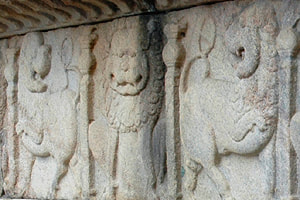
Furthermore, the stage for the tree in the centre of the temple is decorated with a continuous band of lions. These lion bas-reliefs are of similar or even larger size than those at terraces or walls of other ancient structures in Sri Lanka. What is unique in the case of Nillakgama‘s lion frieze is that the animals are shown in side and front view alternately. Frontal representations of lions can also be seen at Manik Vihara in Polonnaruwa or at the stone carvings of the grand staircase of Yapahuwa, which are both from much later periods than Nillakgama. In comparison, the older specimen of this type of lion carvings are much larger.
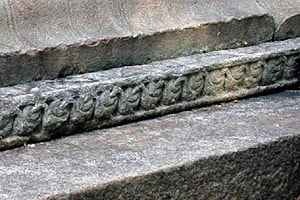
Another extravagance of the is the small goose frieze at the foot of the tree terrace, below the lion frieze. One would expect to see this animal, which symbolizes the leaving of the terrestrial sphere, in decoration bands higher above ground level, as in the case of the Vahalkadas of the relief bands of Kantaka Chetiya in Mihintale.
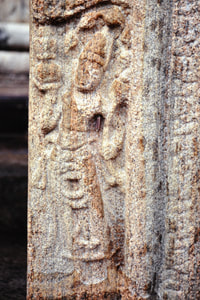
The guardian statues flanking the gate, the Dvarapalas, are shown in the conventional Tribhanga posture (a slight hip swing). However, again there is something exceptional at these Dvarapala. Not only are they of much smaller size than other doorkeepers, what‘s all the more remarkable is that they are depicted on the doorjambs and not on separate guardian steles in front of the entrance or on the walls at its sides. The Dvarapala statue is integrated in an extraordinary composition. All Dvarapalas depicted as Nagarajas (which is the friendly form of guardians which is predominant in Sri Lanka) carry small clay plots out of which creepers grow, a fertility symbol. However, the twines shown at the door jambs of the Nillakgama Bodhigara are much taller than than the Dvarapala figures themselves. Indeed, they form an entire Kalpalata, a wish-fulfilling rank growing to the skies. Kalpalata decoration are otherwise known from tall steles at stupas. A long Kalpalata placed on a jamb and depicted intrinsically combined with a guardian figure is otherwise unknown in Sinhalese art. The overall impression of those almost megalithic doorways of the Nillakgama Bodhigara is that of a very elaborate and distinguished work of art.
Summary
Studying all the details of this seemingly diminutive jewel of ancient Sri Lankan architecture, you will understand the jubilant tone of the words of Senarath Paranivitana cited above. In summary, let's quote another renowned archeologist, Senake Bandaranayake (1938-2015), a former Professor at the University of Kelaniya:
|
“Similarly, despite the prime importance of the bodhi-tree in Sinhalese Buddhism and the ubiquitous presence of a bodhi- tree and a bomaluva (or bo-tree terrace) in contemporary Ceylonese temples, the bodhighara is a shrine which has not received the serious attention of archaeologists in Ceylon. The reasons for this neglect are clear. By its very nature a shrine of this type is much less permanent than a stupa, a cetiyaghara or an image-house, and its remains are more easily obscured in the ruins and debris that confront the archaeologist at every ancient site. Moreover, with the single exception of the remains under the Mahabodhi Temple at Bodhgaya, no example of a bodhigbara has yet been identified in India. The result of all this has been that the bodhighara has come to be regarded as a kind of historical phantom of no particular archaeological substance. In recent times, however, this neglect has been to some extent rectified with the discovery and identification of five or six shrines of this type in Ceylon, all dating from the Anuradhapura Period. The most dramatic of these discoveries was an extremely well-preserved example at Nillakgama, dating from the 8th or 9th Century. This structure was originally noticed by Bell, who published detailed drawings of it, but its true identity eluded him [...] It was Paranavitana who, many years later, identified and dated the shrine on the basis of inscriptional evidence.”
cited from: Bandaranayake, Senake. Sinhalese monastic architecture: the Viharas of Anuradhapura. Studies in South Asian culture, Nr. 4. Hrsg. by Senake Bandaranayake. Leiden: Brill, 1974, pp. 161-62 |
Visitors of Nillakgama should be aware that this region, though a cultivated area is crowded with wild elephants. Deadly attacks occured in this region between Galgamuwa and Aukana. Particularly in the evening, elephants move to the tanks. The Nillakgama Bodhigara is situated just below the embarkment of such an ancient tank. Termite mounds close to the temple entrance can be inhabited by cobras.
